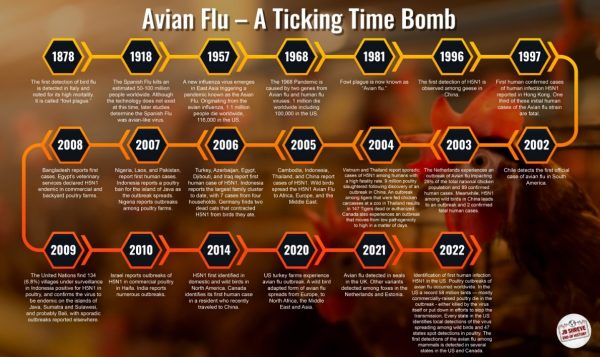April 4, 2025/Midnight
Erie, PA- By now, most people have noticed the extra cash spent at the grocery store. Egg and chicken prices have been steadily rising with no end in sight. The resurgence of avian influenza, commonly known as bird flu, has triggered widespread concern due to its potential health risks and the significant economic impact. This disease is the main cause of higher egg and chicken prices.

As the disease spreads across poultry populations, consumers are feeling the effects in the form of rising egg and chicken prices. The price of eggs has surged to its highest level in 45 years with an average cost of nearly $5 per dozen, a direct consequence of the bird flu outbreak. This rise in prices, alongside the culling of infected chickens, is severely affecting farmers and businesses across the U.S., particularly in states like Georgia, which is a major poultry producer. As the disease extends its reach, consumers have started to wonder what further impact this will have on grocery prices, and the economy as a whole?
Expenses for the past three years show that over $1 billion has been spent due to the aviation flu outbreak. Multiple state’s Departments of Agriculture have shown that not only are consumers being affected, but farmers and producers are being restricted and are losing profit as well. These statistics show that egg prices are the highest they have been in 45 years.
The most relevant information for the consumer is that prices have been increasing, and most likely will continue to increase until the spread of the disease is under control. The average cost for a dozen eggs in America are almost $5.
Certain states are feeling the impact more than others. Georgia, one of the country’s largest poultry producers, Department of Agriculture had issued a statewide ban on poultry exhibitions, swaps, shows, meets, and sales. The cause of the ban comes from Elbert County, where bird flu was detected in two commercial poultry flocks. It was recently lifted in February, however businesses in the area still felt the effects of the ban. The Georgia poultry industry supports over 100,000 jobs. The statewide ban put a halt on all these jobs for about a month, meaning many businesses would see a profit loss.
Trends indicate prices will continue to rise in places like grocery stores and smaller chains. Larger companies, like McDonald’s, will not be seeing a great increase in price, since they are able to absorb the higher prices. There is also an increase in the number of chickens being culled, which will not decrease until the disease is able to be more controlled.
Jesse Cammarata, the owner of Brew Ha Ha, states, “We have felt the impact of egg prices. Essentially half of our food menu incorporates eggs, so we were especially affected by the increase in cost.”
Cammarata continues, “We typically raise our prices every other year, and we had been planning to implement a raise this year anyways. However, we were forced to do a more dramatic increase, particularly on food, due to eggs. Most customers have been very understanding, and we are lucky to have such a loyal base of support, but people noticed the change.”
The rise in bird flu is projected to continue inflating the price of eggs, especially in U.S. states that have specific requirements for selling eggs, like requiring cage free eggs. In an interview, Gannon University’s Richard Hauser, a professor in finance and economics, states, “There are a couple states that have gone to mandating cage-free eggs.”
He continues, “California, obviously, big state, is one of the states that has a mandate on cage-free eggs. So, in California, they’re closer to $10 a dozen. So, the West Coast is by far the highest price because most of the West Coast is requiring cage-free eggs.”
While individual consumers may feel the impact of eggs in their grocery carts and on their kitchen tables, the price increase also has the potential to negatively impact small businesses. Restaurants and other businesses that rely on eggs or chicken products as a primary ingredient will see an increase in the price of their goods, and in many cases will raise the price of their products to keep up with demand.
The U.S. has also begun considering long term solutions for the bird flu crisis. One of these solutions is ramping up the number of eggs that are imported into the country from places like Turkey, which currently is the largest exporter of eggs to the United States. Another long-term solution is creating a vaccine for bird flu.
The U.S. is also focusing on giving aid to farmers, to help them recover their farms and their animals if bird flu has affected them. Hauser states that the government has spent, “500 million for biosecurity, 400 million to aid to the farmers, and a 100 million for research and therapeutics.”
While the prices of eggs are expected to rise, the government has put together a response to manage the price of eggs and contain further outbreaks of bird flu.
One surprising effect of bird flu is the possibility that both wages and costs of living increase. Hauser states, “Another one [effect] that’s worrisome is how it affects our expectations. Because one of the things that the Federal Reserve does is a survey, and what it tracks is people’s inflation expectations.”
He adds, “What’s been happening is because food inflation is so much in your face, you see it every week, people are expecting prices to go up more in the future. What that does is it translates into people’s expectations, which become reality in the future. Because if it’s in your face like that and you start expecting egg prices to go up, when you go to your job, you’re going to demand higher wages. And then that raises prices.”
The continued rise in egg prices and poultry shortages due to the spread of bird flu is creating a ripple effect across the economy, with farmers, businesses, and consumers all feeling the strain. As the disease spreads and suppliers grapple with the loss of production, prices will likely continue to rise, affecting both the cost of groceries and the broader agricultural sector.
As the bird flu continues to wreak havoc on poultry populations, the ripple effects on both the economy and consumer behaviors are undeniable. Rising egg and chicken prices coupled with the culling of infected flocks have already strained farmers, businesses, and consumers alike. While larger companies may be able to absorb the increased costs, small businesses, especially those in the food service industry, are feeling the pressure to raise prices or absorb losses.
With global egg imports increasing and innovative strategies like bird flu vaccines on the horizon, the future of poultry production remains uncertain. Prices continue to rise, impacting every corner of the economy, and consumers will have to navigate the ongoing challenges of inflated food prices for the future.







